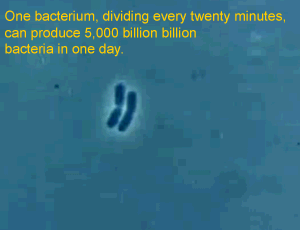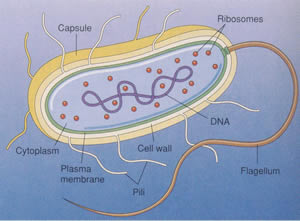Bacteria |
Bacteria are extremely small organisms about 2-8 micro-metres in length. In fact, the only other organisms that are smaller are viruses.
Hundreds of thousands of bacteria can fit on the tip of a pin, as shown on the right. |
|
|
Click on the blue writing to reveal further information.
They reproduce by splitting in two and most need warm moist conditions in which to thrive.
In exreme conditions the bacterium forms a protective structure called an endospore in order to survive. Several steps are involved.
Step 1 -The bacterium replicates its DNA.
Step 2 -The new DNA and some cytoplasm
gather at one end of the cell where they are separated by the plasma membrane.
Step 3 -Water now diffuses out of this seperated segment
and a protein coat develops around it forming the endospore.
Step 4
-The original cell wall dissolves releasing the endospore. |
|
|
| Bacteria have a simple internal structure, and no membrane bound organelles. A basic structure is shown on the right with the notable absence of mitochondria. |
|
|
| The capsule is a layer of polysaccharides or proteins that protects the bacterial cell. It is often associated with pathogenic bacteria and serves as a barrier against phagocytosis by white blood cells. |
| The cell wall is composed of polysaccharides and proteins and maintains the overall shape of the cell. Three primary shapes in bacteria exist, they are coccus (spherical), bacillus (rod-shaped) and spirillum (spiral). Other types of bacteria do exist that have no cell wall and have no definite shape. |
| The cell membrane is formed from a lipid bilayer similar to that of other cells. Numerous proteins float within this lipid bilayer which are responsible for transport of ions, nutrients and waste across the membrane. |
| Ribosomes float in the cytoplasm and give the bacteria a granular appearance when viewed under an electron microscope. These ribosomes are smaller than those of other organisms but their function is the same. |
| DNA in the bacteria is generally confined to a central region of the cytoplasm and not bound by a nuclear membrane. |
| Pilli are hollow, hairlike structures made of protein. This structures allow bacteria to attach to other cells and transfer material from cell to cell. |
| The flagella enables the bacterium to move about. Bacteria may have one, or many flagella in different positions on the cell. |
Continue with relative size of bacteria, viuses and cells. |
|


